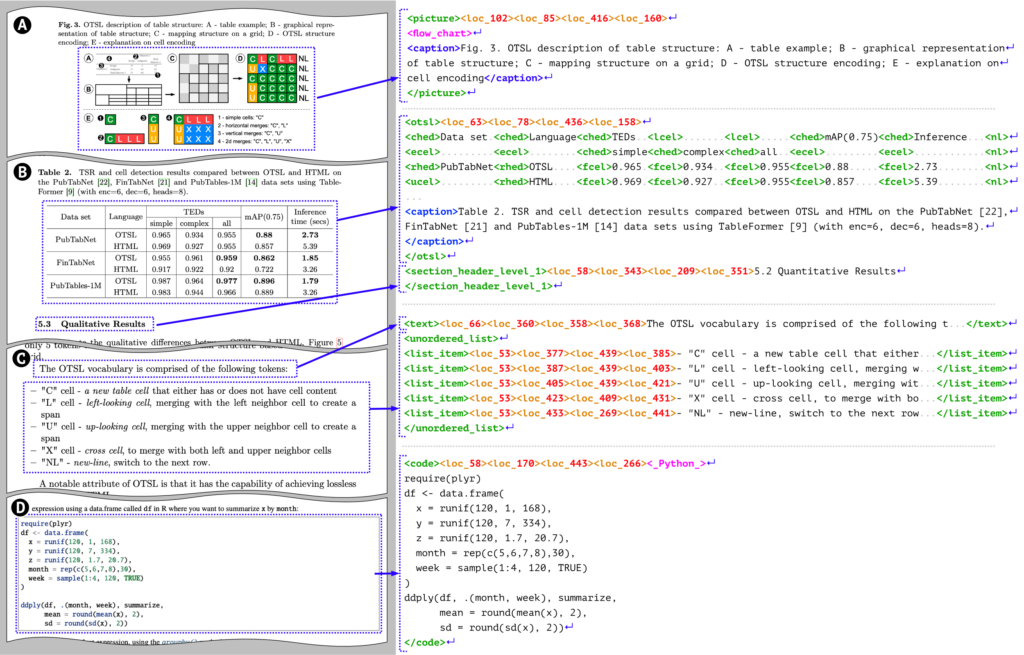SmolDocling, a compact yet robust multimodal model designed to transform images of documents into structured, accessible text.

What Is SmolDocling?
At its core, SmolDocling is a vision-language model that combines the best of image processing and natural language understanding. Developed by the Docling Team in collaboration with IBM Research, this model is designed to handle the complexities of document conversion with a focus on efficiency and accuracy.
Unlike traditional Optical Character Recognition (OCR) systems that might only extract raw text, SmolDocling goes a step further by preserving the structure and formatting of the original document. This means that elements like tables, charts, code blocks, and even mathematical formulas are not just recognized—they’re intelligently formatted and maintained in the conversion process.
Key Features Simplified
Here are some of the standout features that make SmolDocling a game-changer:
- DocTags for Efficient Tokenization:
Instead of relying on traditional tokenization methods, SmolDocling introduces DocTags. These are smart tags that help the model separate and organize the document’s content, making it easier to convert complex layouts into neat, structured text. - Accurate OCR (Optical Character Recognition):
The model excels at reading text from images, ensuring that even challenging fonts and layouts are accurately captured. - Layout and Localization Preservation:
Maintaining the original document’s structure is crucial. SmolDocling keeps track of element positions (like headers, footers, and sidebars) through bounding boxes, ensuring that the converted text retains its original layout. - Specialized Recognition Capabilities:
- Code Recognition: Automatically detects and formats code blocks, preserving essential indentation and formatting.
- Formula Recognition: Identifies mathematical expressions and converts them to formats like LaTeX, making them easier to read and use in academic or technical settings.
- Chart and Table Recognition: Extracts data from charts and recognizes structured tables, including headers, to provide a clear representation of the information.
- Caption Correspondence and List Grouping:
The model links captions with their corresponding images and organizes list elements efficiently, ensuring that nothing gets lost in translation. - Full-Page Conversion:
Whether it’s a single page or an entire document, SmolDocling processes everything—code, equations, charts, and more—making it a versatile tool for various document types.
How Does It Work?
SmolDocling is built on a modern transformer-based architecture and is fine-tuned from the SmolVLM-256M-Instruct model. It leverages cutting-edge techniques in vision-language processing to ensure fast and accurate document conversion. For instance, its integration with VLLM allows it to average just 0.35 seconds per page on high-performance hardware like the A100 GPU.
Moreover, the model’s design emphasizes compatibility. It works seamlessly with Docling—a tool that lets users export the converted documents into multiple formats such as HTML, Markdown, or JSON. This means that once your document is processed by SmolDocling, you have a range of options for how to use and share your newly formatted text.
Practical Applications
SmolDocling isn’t just a theoretical innovation—it has real-world applications across various fields:
- Academic Research: Convert scientific papers, textbooks, and lecture notes into searchable, editable text.
- Business Documentation: Digitize invoices, reports, and contracts while preserving important formatting.
- Education: Make study materials more accessible by transforming printed documents into digital formats.
- Software Development: Automatically format and extract code blocks from technical documentation.
Its ability to handle both scientific and non-scientific documents makes it an adaptable tool for anyone looking to streamline document processing.
The Road Ahead
While SmolDocling already packs a powerful set of features, the future holds even more promise. Planned enhancements include better chart recognition, one-shot multi-page inference, and even chemical recognition. These improvements will further cement SmolDocling as a must-have tool for modern document conversion tasks.
Conclusion
SmolDocling represents a significant leap forward in the world of document conversion. Its compact size, efficient processing, and advanced recognition capabilities mean that converting complex documents into structured text has never been easier. Whether you’re a researcher, developer, or business professional, SmolDocling can help you save time, reduce errors, and unlock valuable insights hidden within your documents.
Happy converting!
